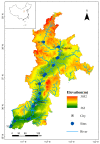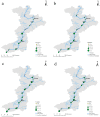Distribution, Site-Specific Water Quality Criteria, and Ecological Risk Assessment of Heavy Metals in Surface Water in Fen River, China
- PMID: 37624209
- PMCID: PMC10458924
- DOI: 10.3390/toxics11080704
Distribution, Site-Specific Water Quality Criteria, and Ecological Risk Assessment of Heavy Metals in Surface Water in Fen River, China
Abstract
Due to a lack of toxicity reference values that match the regional environmental characteristics, the ecological risk of metals in water bodies cannot be accurately assessed. The Fen River is the second-largest tributary of the Yellow River in China, and the sustainability of this area is threatened by heavy metal pollution caused by intensive industrial and agricultural activities. In this study, site-specific water quality criteria (WQCs) for heavy metals in the Fen River were derived considering toxicity data from native aquatic organisms and regional water quality factors (e.g., water hardness). Short-term WQCs for Mn, Cu, Cd, Zn, Cr, Pb, and Ni were 2026.15, 98.62, 10.02, 63.07, 6.06, 166.74, and 132.73 μg/L, respectively, and long-term WQCs were 166.53, 29.71, 2.18, 19.29, 4.15, 6.38, and 14.76 μg/L, respectively. The distribution characteristics of these metals during the wet season in 2020 were explored, and their average concentrations in the river water did not exceed the environmental quality standards for surface water in China but were higher than the world average levels. Cr was the main pollutant in the sampling sites of Yaodu region, Hongdong Shitan, Xiao River, and Duanchun River, as was Pb in Duanchun River. Based on the site-specific WQCs, using hazardous quotient (HQ) and margin of safety (MOS10) approaches, a high risk of Pb was identified in the Duanchun River, and a medium risk of Cr might occur at midstream and downstream of Yaodu and Xiaodian. The results will provide a reference basis for heavy metal pollution control and water quality management in the Fen River.
Keywords: Fen River; ecological risk assessment; ecotoxicity; heavy metals; water quality criteria.
Conflict of interest statement
The authors declare no conflict of interest.
Figures








Similar articles
-
Assessment of heavy metals in surface water, sediment and macrozoobenthos in inland rivers: a case study of the Heihe River, Northwest China.Environ Sci Pollut Res Int. 2022 May;29(23):35253-35268. doi: 10.1007/s11356-022-18663-8. Epub 2022 Jan 20. Environ Sci Pollut Res Int. 2022. PMID: 35060050
-
[Pollution Distribution and Ecological Risk Assessment of Heavy Metals in River Sediments from the Ancient Town of Suzhou].Huan Jing Ke Xue. 2021 Jul 8;42(7):3206-3214. doi: 10.13227/j.hjkx.202011048. Huan Jing Ke Xue. 2021. PMID: 34212646 Chinese.
-
[Research on the Content Characteristics and Pollution Evaluation of Heavy Metals in Filtered Water and Suspended Particles from Gansu, Ningxia and Inner Mongolia Sections of the Yellow River in Wet Season Using HR-ICP-MS].Guang Pu Xue Yu Guang Pu Fen Xi. 2015 Oct;35(10):2872-7. Guang Pu Xue Yu Guang Pu Fen Xi. 2015. PMID: 26904835 Chinese.
-
Spatiotemporal variations, sources, water quality and health risk assessment of trace elements in the Fen River.Sci Total Environ. 2021 Feb 25;757:143882. doi: 10.1016/j.scitotenv.2020.143882. Epub 2020 Dec 3. Sci Total Environ. 2021. PMID: 33316508
-
[Evaluation and Source Analysis of Heavy Metal Pollution in Sediments of the Yellow River Basin Based on Monte Carlo Simulation and PMF Model].Huan Jing Ke Xue. 2022 Aug 8;43(8):4008-4017. doi: 10.13227/j.hjkx.202111172. Huan Jing Ke Xue. 2022. PMID: 35971699 Chinese.
Cited by
-
Ecological Risk Assessment and Source Identification of Heavy Metals in Soils from Shiyang River Watershed in Northwest China.Toxics. 2023 Sep 29;11(10):825. doi: 10.3390/toxics11100825. Toxics. 2023. PMID: 37888676 Free PMC article.
References
-
- Rahman Z., Singh V.P. The relative impact of toxic heavy metals (THMs) (arsenic (As), cadmium (Cd), chromium (Cr)(VI), mercury (Hg), and lead (Pb)) on the total environment: An overview. Environ. Monit. Assess. 2019;191:419. - PubMed
-
- Cui L., Wang X.N., Li J., Liu Z.T. Ecological and health risk assessments and water quality criteria of heavy metals in the Haihe River. Environ. Pollut. 2021;276:116628. - PubMed
-
- Niu Y., Jiang X., Wang K., Xia J.D., Jiao W., Niu Y., Yu H. Meta-analysis of heavy metal pollution and sources in surface sediments of Lake Taihu, China. Sci. Total Environ. 2020;700:134509. - PubMed
-
- Anwar H., Shahid M., Natasha, Niazi N.K., Khalid S., Tariq T.Z., Ahmad S., Nadeem M., Abbas G. Risk assessment of potentially toxic metal(loid)s in Vigna radiata L. under wastewater and freshwater irrigation. Chemosphere. 2021;265:129124. - PubMed
Grants and funding
LinkOut - more resources
Full Text Sources

